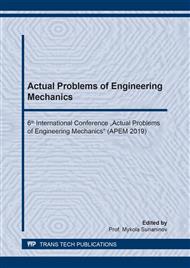[1]
Lu, Jian, ed. Handbook of measurement of residual stresses. Fairmont Press, (1996).
Google Scholar
[2]
Masubuchi, Koichi. Analysis of welded structures: residual stresses, distortion, and their consequences. Vol. 33. Elsevier, (2013).
Google Scholar
[3]
Radaj, Dieter. Welding residual stresses and distortion., Calculation and measurement, DVS-Verlag, Dusseldorf (2003).
Google Scholar
[4]
Fricke, S., E. Keim, and J. Schmidt. Numerical weld modeling—a method for calculating weld-induced residual stresses., Nuclear Engineering and Design 206.2-3 (2001): 139-150.
DOI: 10.1016/s0029-5493(00)00414-3
Google Scholar
[5]
Vrancken, Bey, et al. Residual stress via the contour method in compact tension specimens produced via selective laser melting.,Scripta Materialia 87 (2014): 29-32.
DOI: 10.1016/j.scriptamat.2014.05.016
Google Scholar
[6]
Osadchuk V A, Tsymbalyuk L I, Dzyubyk A R. Determination of the triaxial distribution of residual stresses in welded joints of structural elements with rectilinear seams and estimation of their influence on joint strength in the presence of crack-type defects // Journal of Mathematical Sciences, Vol.183, No.2, May, 2012, P. 150 – 161.
DOI: 10.1007/s10958-012-0803-6
Google Scholar
[7]
He, M. Y., Evans, A. G., & Hutchinson, J. W. (1994). Crack deflection at an interface between dissimilar elastic materials: role of residual stresses. International Journal of Solids and Structures,31 (24), 3443-3455.
DOI: 10.1016/0020-7683(94)90025-6
Google Scholar
[8]
Beghini, Marco, and Leonardo Bertini. Fatigue crack propagation through residual stress fields with closure phenomena.Engineering Fracture Mechanics 36.3 (1990): 379-387.
DOI: 10.1016/0013-7944(90)90285-o
Google Scholar
[9]
Nejad, Reza Masoudi, Khalil Farhangdoost, and Mahmoud Shariati. Numerical study on fatigue crack growth in railway wheels under the influence of residual stresses., Engineering Failure Analysis 52 (2015): 75-89.
DOI: 10.1016/j.engfailanal.2015.03.002
Google Scholar
[10]
Prime, Michael B. Residual stress measurement by successive extension of a slot: the crack compliance method. Applied Mechanics Reviews 52.2 (1999): 75-96.
DOI: 10.1115/1.3098926
Google Scholar
[11]
He, Ming Yuan, Anthony G. Evans, and John W. Hutchinson. Crack deflection at an interface between dissimilar elastic materials: role of residual stresses., International Journal of Solids and Structures 31.24 (1994): 3443-3455.
DOI: 10.1016/0020-7683(94)90025-6
Google Scholar
[12]
Galatolo, Roberto, and Agostino Lanciotti. Fatigue crack propagation in residual stress fields of welded plates., International Journal of Fatigue 19.1 (1997): 43-49.
DOI: 10.1016/s0142-1123(96)00046-1
Google Scholar
[13]
Chang, Kyong-Ho, and Chin-Hyung Lee. Residual stresses and fracture mechanics analysis of a crack in welds of high strength steels., Engineering Fracture Mechanics 74.6 (2007): 980-994.
DOI: 10.1016/j.engfracmech.2006.08.012
Google Scholar
[14]
Muskhelishvili N. I. Some basic problems of the mathematical theory of elasticity. Springer Science & Business Media, (2013).
Google Scholar
[15]
Maksymovych O., Pasternak Ia., Sulym H., Kutsyk S. Doubly periodic cracks in the anisotropic medium with the account of contact of their faces // Acta mechanica et automatica. – 2014. – Vol. 8, No. 3. – P. 160–164.
DOI: 10.2478/ama-2014-0029
Google Scholar
[16]
Bozhydarnik, V.V., Maksymovych, O.V. (2010) Determination of the stressed state near edge cracks in a plate containing a hole of complex shape Materials Science, 46 (1), pp.16-26.
DOI: 10.1007/s11003-010-9259-3
Google Scholar


